七年级英语笔记大全
初一上册英语重点笔记

初一上册英语重点笔记一、单词部分。
1. 名词。
- 可数名词复数变化规则。
- 一般情况加 -s,如book - books,pen - pens。
- 以s,x,sh,ch结尾的加 -es,如bus - buses,box - boxes,brush - brushes,watch - watches。
- 以辅音字母+y结尾的,变y为i加 -es,如baby - babies。
- 以f或fe结尾的,变f或fe为v加 -es,如knife - knives,leaf - leaves(但也有特殊情况,如roof - roofs)。
- 重点名词。
- family(家庭;家人):作“家庭”时是单数,作“家人”时是复数概念。
例如:My family is a big one.(我的家庭是个大家庭。
)My family are all at home.(我的家人都在家。
)- friend(朋友):复数形式是friends,make friends with sb.(和某人交朋友)。
- school(学校):at school(在学校,指在上学),go to school(去上学)。
- class(班级;课):in class(在课堂上),have classes(上课)。
2. 代词。
- 人称代词主格和宾格。
- 主格:I(我),you(你;你们),he(他),she(她),it(它),we(我们),they(他们;她们;它们)。
- 宾格:me,you,him,her,it,us,them。
例如:I like him.(我喜欢他。
主格I作主语,宾格him作宾语)- 物主代词。
- 形容词性物主代词:my(我的),your(你的;你们的),his(他的),her (她的),its(它的),our(我们的),their(他们的;她们的;它们的)。
例如:This is my book.(这是我的书。
形容词性物主代词my修饰名词book)- 名词性物主代词:mine,yours,his,hers,its,ours,theirs。
初一英语笔记
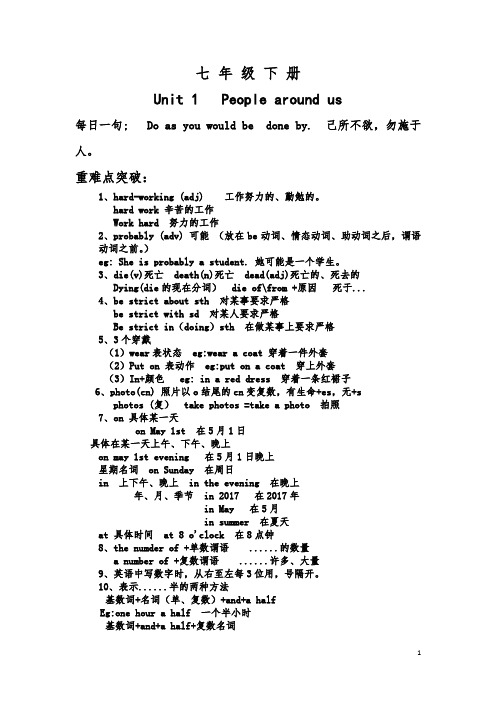
七年级下册Unit 1 People around us每日一句; Do as you would be done by. 己所不欲,勿施于人。
重难点突破:1、hard-working (adj) 工作努力的、勤勉的。
hard work 辛苦的工作Work hard 努力的工作2、probably (adv) 可能(放在be动词、情态动词、助动词之后,谓语动词之前。
)eg: She is probably a student. 她可能是一个学生。
3、die(v)死亡 death(n)死亡 dead(adj)死亡的、死去的Dying(die的现在分词) die of\from +原因死于...4、be strict about sth 对某事要求严格be strict with sd 对某人要求严格Be strict in(doing)sth 在做某事上要求严格5、3个穿戴(1)wear表状态 eg:wear a coat 穿着一件外套(2)Put on 表动作 eg:put on a coat 穿上外套(3)In+颜色 eg: in a red dress 穿着一条红裙子6、photo(cn) 照片以o结尾的cn变复数,有生命+es,无+sphotos (复) take photos =take a photo 拍照7、on 具体某一天on May 1st 在5月1日具体在某一天上午、下午、晚上on may 1st evening 在5月1日晚上星期名词 on Sunday 在周日in 上下午、晚上 in the evening 在晚上年、月、季节 in 2017 在2017年in May 在5月in summer 在夏天at 具体时间 at 8 o'clock 在8点钟8、the numder of +单数谓语 ......的数量a number of +复数谓语 ......许多、大量9、英语中写数字时,从右至左每3位用,号隔开。
英语书笔记七年级上册

英语书笔记七年级上册一、Starter Unit 1 Good morning!1. 重点单词。
- good好的;morning早晨;上午;afternoon下午;evening晚上;night夜晚;hi嗨(用于打招呼);hello你好。
- 注意“good night”用于晚上告别,而“good evening”用于晚上见面打招呼。
2. 重点句型。
- Good morning/afternoon/evening! 用于不同时间段的问候。
- - How are you? - I'm fine, thank you. 这是常见的问候与回应方式。
3. 语法点。
- 字母的大小写及书写规范。
例如,大写字母一般用于句首、专有名词等。
二、Starter Unit 2 What's this in English?1. 重点单词。
- what什么;is是(用于第三人称单数);this这;这个;in用(表示使用的语言等);English英语;a/an一个(a用于辅音音素开头的单词前,an用于元音音素开头的单词前);map地图;cup杯子;ruler尺子;pen钢笔;orange橙子;jacket夹克衫;key钥匙;quilt被子;it它。
2. 重点句型。
- What's this in English? - It's a/an... 这是询问某个物品用英语怎么说的句型。
- Spell it, please. -... 用于请求对方拼写单词。
3. 语法点。
- 不定冠词a和an的用法区别。
例如,“an apple”,“a book”。
三、Starter Unit 3 What color is it?1. 重点单词。
- color颜色;red红色(的);blue蓝色(的);black黑色(的);white白色(的);purple紫色(的);yellow黄色(的);green绿色(的);the定冠词,表示特指。
2024年英语七年级上册课堂笔记
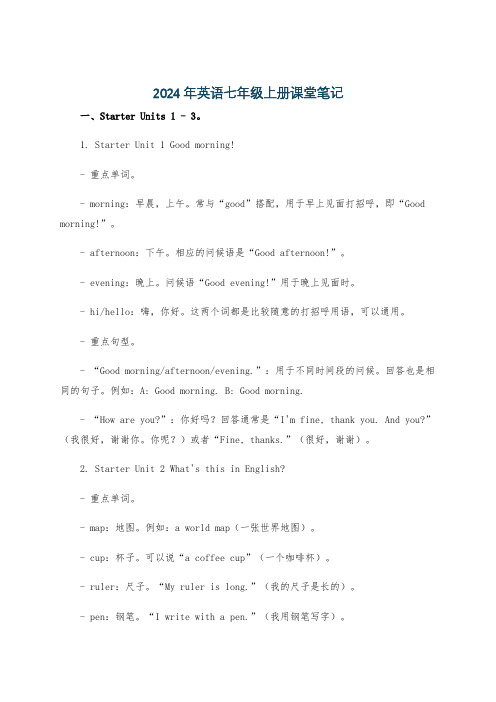
2024年英语七年级上册课堂笔记一、Starter Units 1 - 3。
1. Starter Unit 1 Good morning!- 重点单词。
- morning:早晨,上午。
常与“good”搭配,用于早上见面打招呼,即“Good morning!”。
- afternoon:下午。
相应的问候语是“Good afternoon!”。
- evening:晚上。
问候语“Good evening!”用于晚上见面时。
- hi/hello:嗨,你好。
这两个词都是比较随意的打招呼用语,可以通用。
- 重点句型。
- “Good morning/afternoon/evening.”:用于不同时间段的问候。
回答也是相同的句子。
例如:A: Good morning. B: Good morning.- “How are you?”:你好吗?回答通常是“I'm fine, thank you. And you?”(我很好,谢谢你。
你呢?)或者“Fine, thanks.”(很好,谢谢)。
2. Starter Unit 2 What's this in English?- 重点单词。
- map:地图。
例如:a world map(一张世界地图)。
- cup:杯子。
可以说“a coffee cup”(一个咖啡杯)。
- ruler:尺子。
“My ruler is long.”(我的尺子是长的)。
- pen:钢笔。
“I write with a pen.”(我用钢笔写字)。
- orange:作名词时,意为“橙子,橘子”;作形容词时,意为“橙色的”。
例如:an orange(一个橙子),an orange coat(一件橙色的外套)。
- 重点句型。
- “What's this in English?”:这个用英语怎么说?回答:“It'sa/an...”。
例如:A: What's this in English? B: It's a pen.- “Spell it, please.”:请拼写它。
2024七年级英语上册人教版笔记
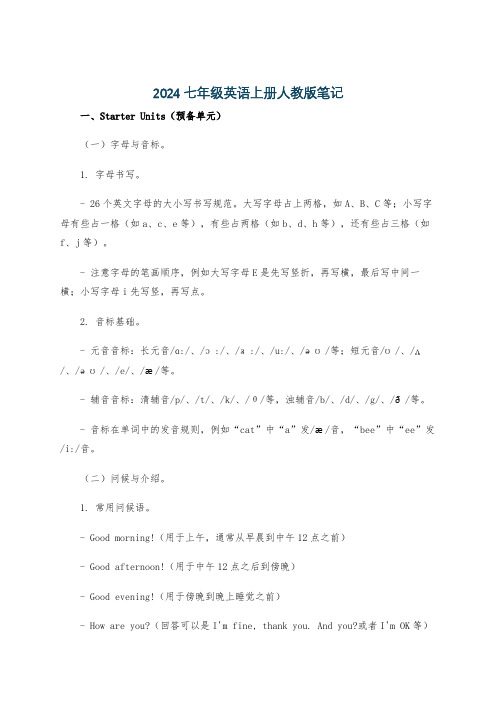
2024七年级英语上册人教版笔记一、Starter Units(预备单元)(一)字母与音标。
1. 字母书写。
- 26个英文字母的大小写书写规范。
大写字母占上两格,如A、B、C等;小写字母有些占一格(如a、c、e等),有些占两格(如b、d、h等),还有些占三格(如f、j等)。
- 注意字母的笔画顺序,例如大写字母E是先写竖折,再写横,最后写中间一横;小写字母i先写竖,再写点。
2. 音标基础。
- 元音音标:长元音/ɑ:/、/ɔ:/、/ɜ:/、/u:/、/əʊ/等;短元音/ʊ/、/ʌ/、/əʊ/、/e/、/æ/等。
- 辅音音标:清辅音/p/、/t/、/k/、/θ/等,浊辅音/b/、/d/、/g/、/ð/等。
- 音标在单词中的发音规则,例如“cat”中“a”发/æ/音,“bee”中“ee”发/i:/音。
(二)问候与介绍。
1. 常用问候语。
- Good morning!(用于上午,通常从早晨到中午12点之前)- Good afternoon!(用于中午12点之后到傍晚)- Good evening!(用于傍晚到晚上睡觉之前)- How are you?(回答可以是I'm fine, thank you. And you?或者I'm OK等)2. 自我介绍。
- My name's...(例如My name's Tom.)- I'm...(I'm a student.)二、Unit 1 My name's Gina.(一)重点单词。
1. name.- 名词,名字。
例如:What's your name?2. nice.3. to.- 在这里是不定式符号,如Nice to meet you中的to;也可作介词,表示“到……”,例如go to school。
4. meet.- 动词,遇见;会面。
例如:Nice to meet you.5. too.- 副词,也;太。
2024年英语七年级上册课堂笔记
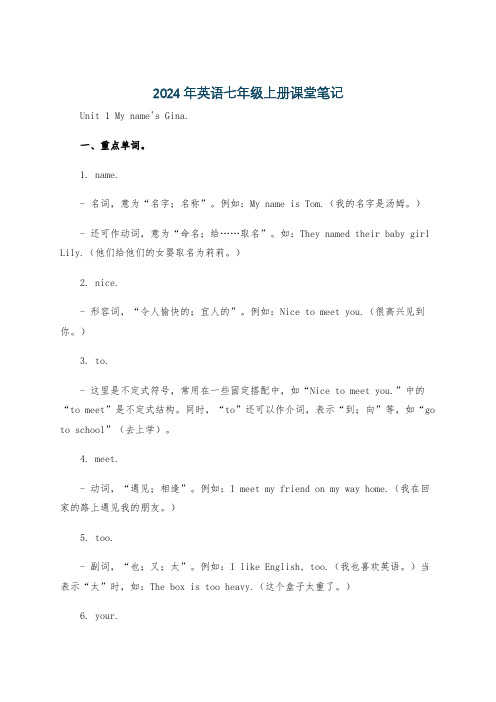
2024年英语七年级上册课堂笔记Unit 1 My name's Gina.一、重点单词。
1. name.- 名词,意为“名字;名称”。
例如:My name is Tom.(我的名字是汤姆。
)- 还可作动词,意为“命名;给……取名”。
如:They named their baby girl Lily.(他们给他们的女婴取名为莉莉。
)2. nice.- 形容词,“令人愉快的;宜人的”。
例如:Nice to meet you.(很高兴见到你。
)3. to.- 这里是不定式符号,常用在一些固定搭配中,如“Nice to meet you.”中的“to meet”是不定式结构。
同时,“to”还可以作介词,表示“到;向”等,如“go to school”(去上学)。
4. meet.- 动词,“遇见;相逢”。
例如:I meet my friend on my way home.(我在回家的路上遇见我的朋友。
)5. too.- 副词,“也;又;太”。
例如:I like English, too.(我也喜欢英语。
)当表示“太”时,如:The box is too heavy.(这个盒子太重了。
)6. your.- 形容词性物主代词,“你的;你们的”。
例如:Your book is on the desk.(你的书在桌子上。
)7. his.- 形容词性物主代词,“他的”。
例如:His name is Jack.(他的名字是杰克。
)8. her.- 形容词性物主代词,“她的”。
例如:Her pen is red.(她的钢笔是红色的。
)二、重点短语。
1. name's = name is.- 例如:My name's Gina. = My name is Gina.(我的名字是吉娜。
)2. nice to meet you.- 用于初次见面时的问候语,回答是“Nice to meet you, too.”(很高兴见到你。
2024年初一英语笔记
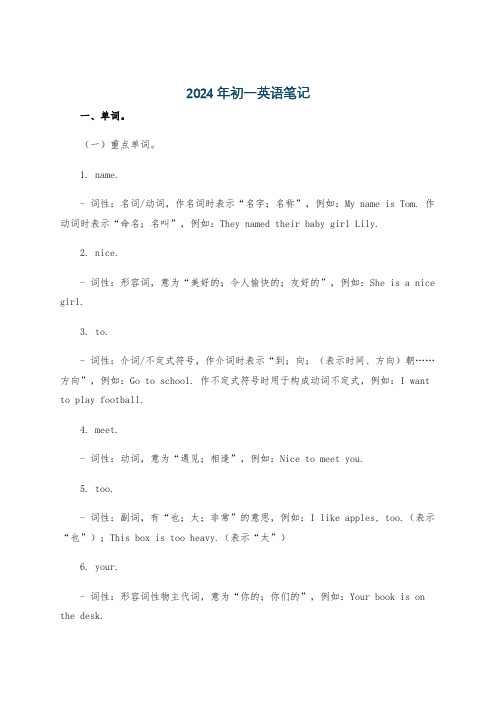
2024年初一英语笔记一、单词。
(一)重点单词。
1. name.- 词性:名词/动词,作名词时表示“名字;名称”,例如:My name is Tom. 作动词时表示“命名;名叫”,例如:They named their baby girl Lily.2. nice.- 词性:形容词,意为“美好的;令人愉快的;友好的”,例如:She is a nice girl.3. to.- 词性:介词/不定式符号,作介词时表示“到;向;(表示时间、方向)朝……方向”,例如:Go to school. 作不定式符号时用于构成动词不定式,例如:I want to play football.4. meet.- 词性:动词,意为“遇见;相逢”,例如:Nice to meet you.5. too.- 词性:副词,有“也;太;非常”的意思,例如:I like apples, too.(表示“也”);This box is too heavy.(表示“太”)6. your.- 词性:形容词性物主代词,意为“你的;你们的”,例如:Your book is on the desk.(二)单词记忆方法。
1. 联想法。
- 对于“name”这个单词,可以联想一个有名字的人或者事物,比如名人的名字。
像“Taylor Swift”,她的名字全世界很多人都知道,这样就容易记住“name”这个单词的含义。
2. 对比记忆法。
- 对比“too”和“to”。
“too”有“也”的意思,在句子中经常用于句末,而“to”更多的是表示方向或者用于构成不定式。
例如:I go to school.(“to”表示方向),I like music, too.(“too”表示“也”)二、短语。
1. nice to meet you.- 用法:用于初次见面时的问候语,回答通常是“Nice to meet you, too.”- 例句:A: Nice to meet you. B: Nice to meet you, too.2. be from.- 用法:表示“来自……”,后面接地点名词。
七上英语2024新版教材笔记

七上英语2024新版教材笔记人教版七年级上册英语2024新版教材笔记。
一、预备篇。
1. 字母。
- 26个英文字母的大小写书写规范。
大写字母占上两格,如A、B、C等;小写字母有的占一格(如a、c、e等),有的占两格(如b、d、h等),还有的占三格(如f、j等)。
- 字母的读音,注意元音字母(a、e、i、o、u)和辅音字母的发音区别。
例如,元音字母在开音节和闭音节中的发音不同。
2. 简单的问候语和自我介绍。
- Hello/Hi:用于熟人或陌生人之间的简单问候,比较随意。
- Good morning/afternoon/evening:根据不同的时间段使用,分别是早上、下午、晚上的问候语,较为正式。
- 自我介绍:“I'm...”(I am的缩写形式),后面接自己的名字,例如“I'm Tom.”二、Unit 1 My name's Gina.1. 重点单词。
- name:名字,可用于询问他人名字,如“What's your name?”- to:在这里是不定式符号,在“Nice to meet you.”中无实际意义。
- meet:遇见,相逢。
- too:也,用于句末,如“I'm fine, too.”- your:你的,你们的,是形容词性物主代词,后面要接名词,如“your name”。
- his:他的;her:她的,这两个也是形容词性物主代词。
2. 重点句型。
- What's your name?- 回答:“My name's...”或者“I'm...”。
- Nice to meet you.- 回答:“Nice to meet you, too.”- Is he/she...?- 回答:“Yes, he/she is.”或者“No, he/she isn't.”例如“Is he Tom? Yes, he is.”三、Unit 2 This is my sister.1. 重点单词。
七年级英语笔记大全

七年级英语笔记大全一. 词汇⑴ 单词1. 介词:in, on, under, behind, near, at, of 1). in表示"在……中", "在……内"。
例如:in our class 在我们班上in my bag 在我的书包里in the desk 在桌子里in the classroom 在教室里2). on 表示"在……上"。
例如:on the wall 在墙上on the desk 在桌子上on the blackboard 在黑板上3). under表示"在……下"。
例如:under the tree 在树下under the chair 在椅子下under the bed 在床下4). behind表示"在……后面"。
例如:behind the door 在门后behind the tree 在树后5). near表示"在……附近"。
例如:near the teacher's desk 在讲桌附近near the bed 在床附近6). at表示"在……处"。
例如:at school 在学校at home 在家at the door 在门口7). of 表示"……的"。
例如:a picture of our classroom 我们教室的一幅画a map of China 一张中国地图2. 冠词 a / an / the:冠词一般位于所限定的名词前,用来署名名词所指的人或事物。
冠词有不定冠词和定冠词两种。
不定冠词有两个形式,即a和an。
a 用在以辅音音素开头的词前,如a book; an用在以元音音素开头的字母前,如an apple.a或an与可数名词单数连用,泛指某类人或某物中的一个。
This is a cat.这是一只猫。
有关初一英语必背知识点笔记
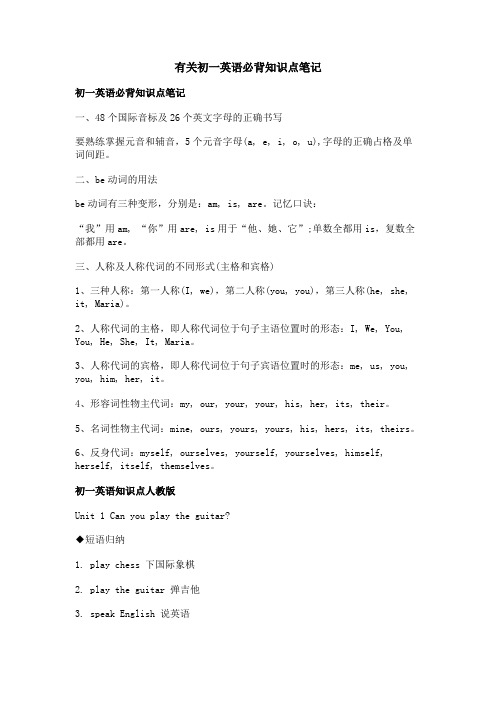
有关初一英语必背知识点笔记初一英语必背知识点笔记一、48个国际音标及26个英文字母的正确书写要熟练掌握元音和辅音,5个元音字母(a, e, i, o, u),字母的正确占格及单词间距。
二、be动词的用法be动词有三种变形,分别是:am, is, are。
记忆口诀:“我”用am, “你”用are, is用于“他、她、它”;单数全都用is,复数全部都用are。
三、人称及人称代词的不同形式(主格和宾格)1、三种人称:第一人称(I, we),第二人称(you, you),第三人称(he, she, it, Maria)。
2、人称代词的主格,即人称代词位于句子主语位置时的形态:I, We, You, You, He, She, It, Maria。
3、人称代词的宾格,即人称代词位于句子宾语位置时的形态:me, us, you, you, him, her, it。
4、形容词性物主代词:my, our, your, your, his, her, its, their。
5、名词性物主代词:mine, ours, yours, yours, his, hers, its, theirs。
6、反身代词:myself, ourselves, yourself, yourselves, himself, herself, itself, themselves。
初一英语知识点人教版Unit 1 Can you play the guitar?◆短语归纳1. play chess 下国际象棋2. play the guitar 弹吉他3. speak English 说英语4. English club 英语俱乐部5. talk to 跟…说6. play the violin 拉小提琴7. play the piano 弹钢琴8. play the drums 敲鼓9. make friends 结交朋友10. do kung fu 练 (中国) 功夫11. tell stories 讲故事12. play games 做游戏13. on the weekend/on weekends 在周末◆用法集萃1. play +棋类/球类下……棋,打……球2. play the +西洋乐器弹/拉……乐器3. be good at doing sth.= do well in doing sth. 擅长做某事4. be good with sb. 和某人相处地好5. need sb. to do sth. 需要某人做某事6. can + 动词原形能/会做某事7. a little + 不可数名词一点儿……8. join the …club 加入…俱乐部9. like to do sth. =love to do sth. 喜欢/喜爱做某事◆典句必背1. Can you draw? Yes, I can. / No, I can’t.2. What club do you want to join? I want to join the chess club.3. You can join the English club.4. Sounds good./That sounds good.5. I can speak English and I can also play soccer.6. Please call Mrs. Miller at 555-3721.Unit 2 What time do you go to school?◆短语归纳1. what time 几点2. go to school 去上学3. get up 起床4. take a shower 洗淋浴5. brush teeth 刷牙6. get to 到达7. do homework 做家庭作业8. go to work 去上班9. go home 回家10. eat breakfast 吃早饭11. get dressed 穿上衣服12. get home 到家13. either…or… 要么…要么…14. go to bed 上床睡觉15. in the morning/ afternoon/ evening 在上午/下午/晚上16. take a walk 散步17. lots of=a lot of 许多,大量18. radio station 广播电台19. at night 在晚上20. be late for=arrive late for 迟到◆用法集萃1. at + 具体时间点在几点(几分)2. eat breakfast/ lunch/dinner 吃早饭/午饭/晚饭3. thirty\half past +基数词……点半4. fifteen\a quarter to +基数词差一刻到……点5. take a/an +名词从事……活动6. from …to … 从……到……7. need to do sth 需要做某事◆典句必背1. What time do you usually get up? I usually get up at six thirty.2. That’s a funny time for breakfast.3. When do students usually eat dinner? They usually eat dinner at a quarter to seven in the evening.4. In the evening, I either watch TV or play computer games.5. At twelve, she eats lots of fruit and vegetables for lunch..6. She knows it’s not good for her, but it tastes good.7. Here are your clothes.Unit 3 How do you get to school?◆短语归纳1. get to school 到达学校2. take the subway 乘地铁3. ride a bike 骑自行车4. how far 多远5. from home to school 从家到学校6. every day 每天7. take the bus 乘公共汽车8. by bike 骑自行车9. bus stop 公共汽车站10. think of 认为11. between … and … 在…和…之间12.one 11-year-old boy 一个11岁的男孩13. play with … 和…玩14. come true 实现15. have to 不得不◆用法集萃1. take… to …= go to … by… 乘…去…2. How do / does (sb)get to …?…是怎样到…的?3. How far is it from … to …?从…到…有多远?4. It takes sb. some time to do sth. 做某事花费某人多长时间。
七年级上册英语书笔记人教版

七年级上册英语书笔记人教版一、Starter Units 1 - 3。
1. Good morning/afternoon/evening.- 这是常见的问候语。
“Good morning”用于早上(通常到中午12点之前);“Good afternoon”用于中午12点之后到傍晚;“Good evening”用于傍晚到晚上睡觉之前。
- 回答也用相同的句子,例如:A: Good morning. B: Good morning.2. How are you?- 用于询问对方的身体状况或近况。
- 常见回答有:“I'm fine, thank you. And you?”“Fine, thanks.”“Not bad.”等。
3. Alphabet.- 26个英文字母的大小写书写。
大写字母一般占上两格,如:A、B、C;小写字母有的占一格(如:a、c、e),有的占两格(如:b、d、h),有的占三格(如:f、j)。
- 字母的读音,例如:A[ei],B[bi:],C[si:]等。
4. Colors.- 基本颜色单词:red(红色)、blue(蓝色)、green(绿色)、yellow(黄色)、black(黑色)、white(白色)等。
- 可以用来描述物体的颜色,例如:The pen is blue.二、Unit 1 My name's Gina.1. Introducing oneself.- “I'm...”和“My name is...”都可以用来介绍自己的名字。
例如:I'm Tom. = My name is Tom.- 在英语中,名字的书写顺序是名在前,姓在后。
2. Asking for someone's name.- “What's your name?”是最常见的询问对方名字的句子。
- 其回答可以是:My name is...或者I'm...3. Nice to meet you.- 用于初次见面时打招呼,回答是“Nice to meet you, too.”4. Telephone numbers.- 数字0 - 9的英语表达:zero,one,two,three,four,five,six,seven,eight,nine。
2024英语七年级上册笔记
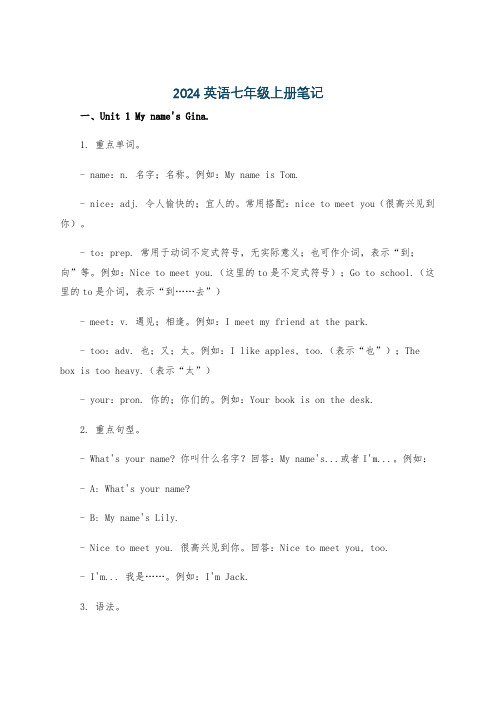
2024英语七年级上册笔记一、Unit 1 My name's Gina.1. 重点单词。
- name:n. 名字;名称。
例如:My name is Tom.- nice:adj. 令人愉快的;宜人的。
常用搭配:nice to meet you(很高兴见到你)。
- to:prep. 常用于动词不定式符号,无实际意义;也可作介词,表示“到;向”等。
例如:Nice to meet you.(这里的to是不定式符号);Go to school.(这里的to是介词,表示“到……去”)- meet:v. 遇见;相逢。
例如:I meet my friend at the park.- too:adv. 也;又;太。
例如:I like apples, too.(表示“也”);The box is too heavy.(表示“太”)- your:pron. 你的;你们的。
例如:Your book is on the desk.2. 重点句型。
- What's your name? 你叫什么名字?回答:My name's...或者I'm...。
例如:- A: What's your name?- B: My name's Lily.- Nice to meet you. 很高兴见到你。
回答:Nice to meet you, too.- I'm... 我是……。
例如:I'm Jack.3. 语法。
- 形容词性物主代词:your(你的;你们的)。
形容词性物主代词后面要接名词。
例如:your pen(你的钢笔)。
二、Unit 2 This is my sister.1. 重点单词。
- sister:n. 姐;妹。
例如:My sister is a student.- brother:n. 兄;弟。
例如:His brother likes playing football.- parent:n. 父(母)亲。
七年级上册英语单词笔记

七年级上册英语单词笔记一、Starter Unit 1 - Good morning!1. good [gʊd] - adj.(形容词)好的。
- 例句:This is a good book.(这是一本好书。
)2. morning ['mɔ:rnɪŋ] - n.(名词)早晨;上午。
- 例句:Good morning!(早上好!)3. hi [haɪ] - interj.(感叹词)嗨;喂。
- 例句:Hi, Tom!(嗨,汤姆!)4. hello [hə'ləʊ] - interj.(感叹词)你好;喂。
- 例句:Hello, everyone!(大家好!)二、Starter Unit 2 - What's this in English?1. what [wɒt] - pron.(代词)& adj.(形容词)什么?- 例句:What's your name?(你叫什么名字?)2. is [ɪz] - v.(动词)是(be的第三人称单数形式)- 例句:He is a student.(他是一名学生。
)3. this [ðɪs] - pron.(代词)这;这个。
- 例句:This is my pen.(这是我的钢笔。
)4. in [ɪn] - prep.(介词)用(表示使用的语言等);在……里。
- 例句:What's this in English?(这个用英语怎么说?)三、Starter Unit 3 - What color is it?1. color ['kʌlə(r)] - n.(名词)颜色。
- 例句:What color do you like?(你喜欢什么颜色?)2. red [red] - adj.(形容词)& n.(名词)红色(的)- 例句:The apple is red.(这个苹果是红色的。
)3. yellow ['jeləʊ] - adj.(形容词)& n.(名词)黄色(的)- 例句:My bag is yellow.(我的包是黄色的。
英语初一上册笔记

英语初一上册笔记一、Starter Units 1 - 3。
1. 字母。
- 26个英文字母的大小写书写规范。
大写字母占上两格,如A、B、C等;小写字母有些占一格(如a、c、e等),有些占两格(如b、d、h等),有些占三格(如f、j等)。
- 字母的读音,元音字母(a, e, i, o, u)和辅音字母的发音区别。
例如,元音字母在开音节和闭音节中的发音不同。
2. 单词。
- 简单的问候语单词:hello(你好),hi(嗨),goodbye(再见),bye(拜拜)。
- 颜色单词:red(红色),blue(蓝色),green(绿色),yellow(黄色),black(黑色),white(白色)。
记忆方法可以采用联想记忆,比如红色联想到苹果,蓝色联想到天空等。
- 表示人物关系的单词:father(父亲),mother(母亲),sister(姐妹),brother(兄弟)。
3. 句型。
- 问候句型:- - Hello! How are you? - I'm fine, thank you.- - Hi! Good morning/afternoon/evening.- 介绍句型:- - This is my father/mother/sister/brother.- - My name is... I'm... years old.二、Unit 1 My name's Gina.1. 重点单词。
- name(名字),nice(美好的),to(不定式符号,无实义),meet(遇见),too(也),your(你的,你们的),his(他的),her(她的)。
- 关于名字的单词:first name(名),last name(姓),例如在英语中,名字在前姓在后,而在中国姓在前名字在后。
2. 重点句型。
- - What's your name? - My name's Gina.- - Nice to meet you. - Nice to meet you, too.- - Is he Jack? - Yes, he is./No, he isn't.- - Are you Helen? - Yes, I am./No, I'm not.3. 语法点。
七年级英语笔记整理
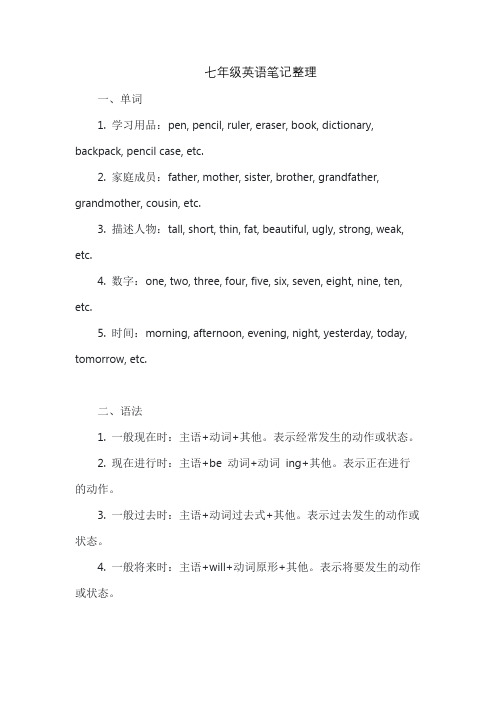
七年级英语笔记整理一、单词1. 学习用品:pen, pencil, ruler, eraser, book, dictionary, backpack, pencil case, etc.2. 家庭成员:father, mother, sister, brother, grandfather, grandmother, cousin, etc.3. 描述人物:tall, short, thin, fat, beautiful, ugly, strong, weak, etc.4. 数字:one, two, three, four, five, six, seven, eight, nine, ten, etc.5. 时间:morning, afternoon, evening, night, yesterday, today, tomorrow, etc.二、语法1. 一般现在时:主语+动词+其他。
表示经常发生的动作或状态。
2. 现在进行时:主语+be 动词+动词ing+其他。
表示正在进行的动作。
3. 一般过去时:主语+动词过去式+其他。
表示过去发生的动作或状态。
4. 一般将来时:主语+will+动词原形+其他。
表示将要发生的动作或状态。
三、句型1. 问候:Hello!/Hi! Good morning/afternoon/evening. How are you? Fine, thanks. And you?2. 介绍:I'm... This is...3. 请求:May I have...? Can I help you?4. 道歉:I'm sorry. Excuse me.5. 告别:Goodbye!/Bye! See you later.。
七年级上册英语课堂笔记全部

七年级上册英语课堂笔记全部一、Starter Units 1 - 3。
(一)重点单词。
1. 问候语相关。
- hello(你好),hi(嗨),good(好的),morning(早晨;上午),afternoon(下午),evening(晚上;傍晚)。
- 用法:“Good morning/afternoon/evening”用于不同时间段的问候。
例如:Good morning! 用于早晨到中午之前的问候。
2. 字母相关。
- 26个英文字母的大小写形式、读音。
大写字母如A - Z,小写字母如a - z。
- 字母的书写规范:字母在四线三格中的位置,如a, c, e等占中间一格;b, d, h等占上两格;g, p, q等占下两格;f占三格。
3. 颜色类。
- red(红色),blue(蓝色),green(绿色),black(黑色),white(白色),yellow(黄色)。
- 例如:This pen is blue.(这支笔是蓝色的。
)(二)重点句型。
1. - How are you? - I'm fine, thank you. And you? - I'm OK.- 这是常见的问候与回应的句型。
“How are you?”用于询问对方的身体状况或近况,回答可以是“fine”(身体好)、“OK”(还不错)等,并且可以反问对方“And you?”。
2. - What's this/that in English? - It's a/an...- 用于询问某个物品用英语怎么说。
例如:What's this in English? It's a book.(这个用英语怎么说?它是一本书。
)注意a用于以辅音音素开头的单词前,an 用于以元音音素开头的单词前,如an apple。
二、Unit 1 My name's Gina.(一)重点单词。
1. 名字相关。
- name(名字),first name(名),last name/family name(姓)。
英语初一笔记

英语初一笔记
以下是英语初一的笔记内容,主要包括语法、词汇和句型等方面:
1. 语法:
现在进行时:表示正在进行的动作或状态,结构为“be动词+动词ing”。
例如:I am studying English.(我正在学习英语。
)
形容词的比较级:表示比较关系,结构为“比较级+than”。
例如:She
is taller than me.(她比我高。
)
序数词:表示顺序,结构为“基数词+序数词”。
例如:the first day
(第一天)。
2. 词汇:
动物类词汇:cat、dog、pig、cow等。
水果类词汇:apple、banana、orange、pear等。
颜色类词汇:red、green、blue、yellow等。
3. 句型:
询问姓名和年龄:What’s your name?How old are you?
询问物品价格:How much is the book?
表示请求或邀请:Can I borrow your pen?Would you like to join us?表示感谢和道歉:Thank you very ’m sorry to hear that.
以上是英语初一的笔记内容,通过学习和掌握这些基础知识,可以为以后的学习打下坚实的基础。
七年级上册笔记英语

七年级上册笔记英语一、Starter Units 1 - 3。
1. 字母。
- 26个英文字母的大小写书写。
大写字母占上两格,如A、B、C等;小写字母有不同的占格情况,如a, c, e占中间一格,b, d, h占上两格,g, p, q占下两格等。
- 字母的读音,例如Aa [eɪ],Bb [bi:],Cc [si:]等。
2. 简单的问候语和介绍用语。
- Greetings(问候)- Good morning(早上好),用于上午见面的问候,一般从早上起床到中午12点之前都可以用。
- Good afternoon(下午好),用于中午12点之后到傍晚的问候。
- Good evening(晚上好),傍晚到睡觉之前的问候。
- Introductions(介绍)- I'm... = I am...(我是……),例如I'm Tom.(我是汤姆。
)- This is...(这是……),用于介绍人或物,如This is my book.(这是我的书。
)3. 数字(0 - 9)- zero [ˈzɪərəʊ],one [wʌn],two [tu:],three [θri:],four [f ɔ:(r)],five [faɪv],six [sɪks],seven [ˈsevn],eight [eɪt],nine [na ɪn]。
可以用来表示数量,如I have two pens.(我有两支笔。
)4. 颜色。
- red [red](红色),blue [blu:](蓝色),green [ɡri:n](绿色),yellow [ˈjeləʊ](黄色),black [blæk](黑色),white [waɪt](白色)等。
例如The pen is red.(这支笔是红色的。
)二、Unit 1 My name's Gina.1. 重点单词。
2. 重点句型。
- What's your name?(你叫什么名字?)回答:My name's...或者I'm...。
七年级英语笔记知识点
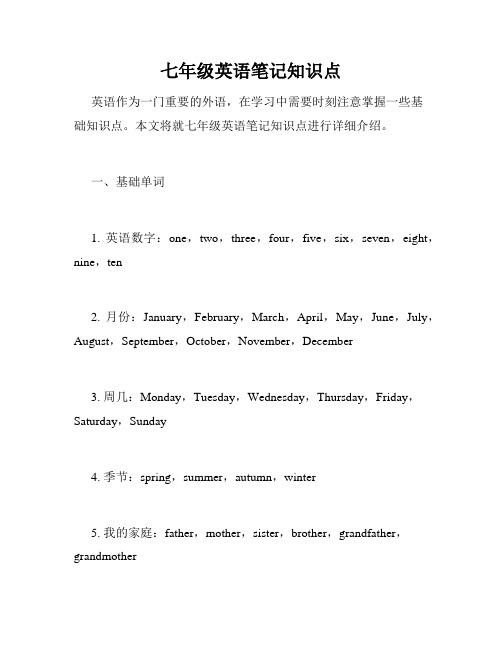
七年级英语笔记知识点英语作为一门重要的外语,在学习中需要时刻注意掌握一些基础知识点。
本文将就七年级英语笔记知识点进行详细介绍。
一、基础单词1. 英语数字:one,two,three,four,five,six,seven,eight,nine,ten2. 月份:January,February,March,April,May,June,July,August,September,October,November,December3. 周几:Monday,Tuesday,Wednesday,Thursday,Friday,Saturday,Sunday4. 季节:spring,summer,autumn,winter5. 我的家庭:father,mother,sister,brother,grandfather,grandmother二、语法知识1. 名词单复数:一般情况下,单数名词在末尾加“s”,复数名词在末尾加“es”。
如:one apple,two apples;a baby,two babies。
2. 动词变化:一般情况下,现在时态加s。
如:I play football. He plays football. 过去时态加ed。
如:I played basketball yesterday.3. 形容词和副词:形容词一般放在名词前,副词一般放在动词后面。
如:She is a beautiful girl. She sings beautifully.三、句子构成1. 主语和谓语:每个完整的句子都要有主语和谓语。
主语一般是第一个词,谓语一般是第二个词。
2. 陈述句和疑问句:陈述句用来陈述事实或者描述事物,疑问句用来问问题或询问某人的具体情况。
3. 简单句和复合句:简单句的结构比较简单,只有一个主语和谓语。
复合句则包含一个主句和一个或多个从句。
四、听力技巧1. 零散听力:听取一些零散的英文单词或者短语,提高听辨能力。
七年级英语笔记
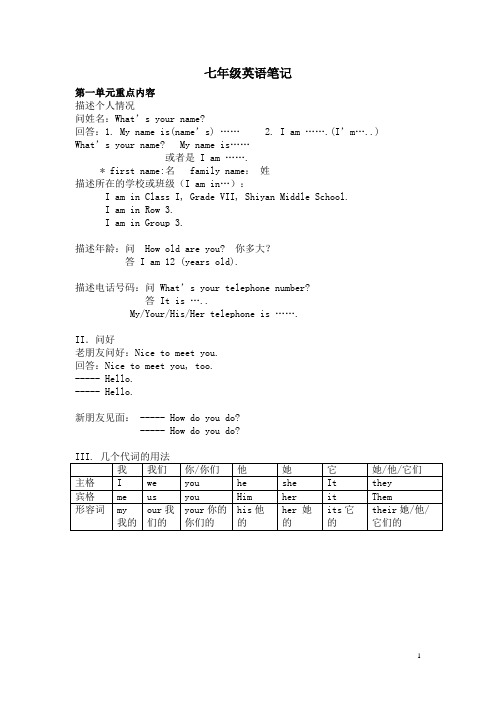
七年级英语笔记第一单元重点内容描述个人情况问姓名:What’s your name?回答:1. My name is(name’s) …… 2. I am …….(I’m…..) What’s your name? My name is……或者是 I am …….* first name:名 family name:姓描述所在的学校或班级(I am in…):I am in Class I, Grade VII, Shiyan Middle School.I am in Row 3.I am in Group 3.描述年龄:问 How old are you? 你多大?答 I am 12 (years old).描述电话号码:问What’s your telephone number?答It is …..My/Your/His/Her telephone is …….II.问好老朋友问好:Nice to meet you.回答:Nice to meet you, too.----- Hello.----- Hello.新朋友见面: ----- How do you do?----- How do you do?主格:这个单词做主语,换句话说,他发出了某一个动作(一般都放在句子开头) I like music. 我喜欢音乐。
I 是主语,因为它发出了like这个动作。
宾格:这个单词做宾语,换句话说,他承受了某一个动作,是一个动作的承受者Music承受了like这个动作。
I like music.He likes me.My name is Chengwei.We are boys.Feng He likes us.Our English teacher is Feng He.You are students.Mr Feng likes you.This is your book.He is a teacher.We like him.His name is Jim.She is a teacher.We like her.Her name is Mary.It is a book.We like it.This is a pencil case. Its color is yellow.They are students.Mr. Feng likes them.Their English teacher is Feng He.一般疑问句:以is, am, are 开头。
- 1、下载文档前请自行甄别文档内容的完整性,平台不提供额外的编辑、内容补充、找答案等附加服务。
- 2、"仅部分预览"的文档,不可在线预览部分如存在完整性等问题,可反馈申请退款(可完整预览的文档不适用该条件!)。
- 3、如文档侵犯您的权益,请联系客服反馈,我们会尽快为您处理(人工客服工作时间:9:00-18:30)。
七年级英语笔记大全一. 词汇⑴单词1. 介词:in, on, under, behind, near, at, of 1). in表示在中,在内。
例如:in our class 在我们班上in my bag 在我的书包里in the desk 在桌子里in the classroom 在教室里2). on 表示在上。
例如:on the wall 在墙上on the desk 在桌子上on the blackboard 在黑板上3). under表示在下。
例如:under the tree 在树下under the chair 在椅子下under the bed 在床下4). behind表示在后面。
例如:behind the door 在门后behind the tree 在树后5). near表示在附近。
例如:near the teachers desk 在讲桌附近near the bed 在床附近6). at表示在处。
例如:at school 在学校at home 在家at the door 在门口7). of 表示的。
例如:a picture of our classroom 我们教室的一幅画a map of China 一张中国地图2. 冠词a / an / the:冠词一般位于所限定的名词前,用来署名名词所指的人或事物。
冠词有不定冠词和定冠词两种。
不定冠词有两个形式,即a和an。
a 用在以辅音音素开头的词前,如a book; an用在以元音音素开头的字母前,如an apple.a或an与可数名词单数连用,泛指某类人或某物中的一个。
This is a cat.这是一只猫。
Its an English book.这是一本英语书。
His father is a worker.他的爸爸是个工人。
the既可以用在可数名词前,也可以用在不可数名词前,表示某个或某些特定的人或事物,也可以指上文提到过的人或事物。
Whos the boy in the hat?戴帽子的男孩是谁呀?------ What can you see in the classroom?------ I can see a bag.------ Wheres the bag?------ Its on the desk.------- 你能在教室里看到什么呀?------ 我能看见一个书包。
------ 书包在哪呀?------ 在桌子上。
3.some和any①在肯定句中用some.例如:There are some books on the desk.桌子上有一些书。
Lucy has some good books露西有一些好书。
②在疑问句和否定句中用any。
例如:Is there any ink in your pen?你的钢笔里有墨水吗?Do you have any brothers and sisters?你有兄弟姐妹吗?There isnt any water in the glass.杯子里没有水。
⑵记住它们的特殊用法。
①some亦可用于表示盼望得到对方肯定的答复或表示建议、委婉请求的疑问句中,这一点我们不久就会学到。
例如:Would you like to have some apples?你想吃苹果吗?②any也可用于肯定句中,表示任何的。
例如:Any one of us can do this.我们当中任何一个都能做这个。
some 和any的用法是经常出现的考点,希望大家能准确地掌握它们的用法。
4.familyfamily看作为一个整体时,意思是家庭,后面的谓语动词be用单数形式is ;如把family看作为家庭成员时,应理解为复数,后面的谓语动词be应用are。
My family is a big family. 我的家庭是个大家庭。
My family are all at home now. 我的家人现在都在家。
Family强调由家人组成的一个集体或强调这个集体中的成员。
home指个人出生、被抚养长大的环境和居住地点。
house指家、房屋,侧重居住的建筑本身。
His family are all workers. 他的家人都是工人。
My home is in Beijing. 我的家在北京。
He isnt at home now. 他现在不在家。
Its a picture of my family. 这是一张我全家的照片。
5. little的用法a little dog 一只小狗,a little boy 一个小男孩。
little常用来修饰有生命的名词。
*但little还可表示否定意义,意为少的,加不可数名词。
There is little time. 几乎没时间了。
There is little water in the cup. 杯中水很少。
⑵词组on the desk 在桌子上behind the chair 在椅子后under the chair 在椅子下面in her pencil-box 在她的铅笔盒中near the door 在门附近a picture of a classroom 一个教室的图片look at the picture 看这张图片the teachers desk 讲桌a map of China 一张中国地图family tree 家谱have a seat 坐下,就坐this way 这边走二. 日常用语1. Come and meet my family.2. Go and see. I think its Li Lei.3. Glad to meet you.4. What can you see in the picture?I can see a clock / some books.5. Can you see an orange?Yes, I can. / No, I cant.6. Wheres Shenzhen?Its near Hong Kong.7. Let me see.(口语)让我想想看。
see 在这是明白、懂了,不可译作看见。
例如:8. Please have a seat.seat表示座位,是个名词。
have a seat表示就坐,也可以说takea seat, 和sit down的意思相同。
三. 语法1. 名词所有格名词如要表示与后面名词的所有关系,通常用名词所有格的形式,意为的。
一般有以下几种形式:(1). 一般情况下在词尾加s。
例如:Kates father Kate的爸爸my mothers friend 我妈妈的朋友(2). 如果复数名词以s结尾,只加。
例如:Teachers Day 教师节The boys game 男孩们的游戏(3). 如果复数名词不以s结尾,仍加s。
例如:Childrens Day 儿童节Womens Day 妇女节(4). 表示两个或几个共有时,所有格应加在后一个名词上。
例如:Lucy and Lilys room Lucy 和Lily的房间Kate and Jims father Kate 和Jim的爸爸动物和无生命事物的名词的所有格一般不在词尾加s,而常常用介词of的短语来表示。
a map of China 一幅中国地图the name of her cat 她的猫的名字a picture of my family 我的家庭的一张照片the door of the bedroom 卧室的门2. 祈使句祈使句主要用来表示说话人的请求、命令、建议、叮嘱等意图。
祈使句一般不用主语,读时用降调。
为使语气委婉、礼貌,常在句首或句尾加please 。
在句尾时,please前多用逗号。
(1). 祈使句肯定形式的谓语动词一律用动词原形。
Go and see. 去看看。
Come in, please. 请进。
(2). 祈使句的否定形式常用dont于句首。
Dont look at your books. 不要看书。
Dont play on the road. 不要在马路上玩。
3. There be 的句子结构There be是一个存在句型,表示有的意思,肯定句的形式为:There be + 名词(单数或复数)+地点状语或时间状语。
be动词单复数的确定,看be后边第一个名词,当所接主语为单数或不可数名词时,be动词形式为is;当所接主语为复数名词时,be 动词为are;当be动词后接两个以上主语时,be动词与最临近主语保持数上的一致。
意思为某地有某人或某物。
如:There is an eraser and two pens on the desk. 桌子上有一块橡皮和两支钢笔。
There are two pens and an eraser on the desk. 桌上有两支钢笔和一块橡皮。
(1)there be的否定句,即在be的后面加上not。
否定形式为:There be + not + (any) + 名词+地点状语。
There is not any cat in the room. 房间里没猫。
There arent any books on the desk. 桌子上没书。
(2)there be句型的疑问句就是将be提到句首:Be there + (any) +名词+地点状语?肯定回答:Yes, there is / are. 否定回答:No, there isnt / arent.---Is there a dog in the picture? 画上有一只狗吗?---Yes, there is. 有。
---Are there any boats in the river? 河里有船吗?---No, there arent. 没有。
(3)特殊疑问句:How many . . . are there (+地点状语)?某地有多少人或物?回答用There be . . .Theres one. / There are two / three / some . . .有时直接就用数字来回答。
One. / Two . . .---How many students are there in the classroom? 教室里有多少学生?---Theres only one. / There are nine. 只有一个。
/有九个。
(4)如果名词是不可数名词,用:How much + 不可数名词+ is there + 地点状语?How much water is there in the cup? 杯中有多少水?How much food is there in the bowl? 碗里有多少食物?。
